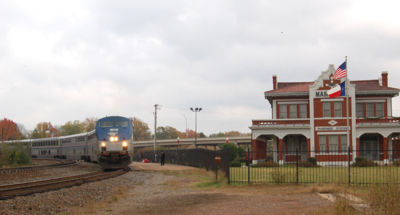Texas Eagle
The Texas Eagle is a 1306-mile (2102 km) passenger train route operated by Amtrak in the central and western United States. Trains run daily between Chicago, Illinois, and San Antonio, Texas, and continue to Los Angeles, California, 2728 miles (4390 km) total, three days a week (incorporated as part of the Sunset Limited).

History
Amtrak's Texas Eagle is the direct successor of the Missouri Pacific Railroad and Texas and Pacific Railway train of the same name, which was inaugurated August 15, 1948. For thirteen years, the Texas Eagle operated as two separate sections, leaving St. Louis in the late afternoon, one following behind the other at an approximately 10 minute interval. At Longview, the routes diverged. The west Texas section continued to Dallas and El Paso, while the south Texas section operated to Austin and San Antonio, where a connection was made to the Aztec Eagle for Laredo and Mexico City. After 1961, the Texas Eagle was consolidated as a single, very long train, between St. Louis and Longview, Texas, where the train was split into several sections, each serving different Texas cities. The west Texas section of the Texas Eagle continued from Longview to Dallas, Fort Worth, and El Paso; the south Texas section served Palestine, Austin, San Antonio, and Laredo, with a through Pullman continuing to Mexico City. A third section of the Texas Eagle split from the main train at Palestine, providing service to Houston.
The route of Amtrak's Texas Eagle is longer (Chicago to San Antonio versus St. Louis to San Antonio), but much of today's route is historically a part of the original Texas Eagle route. St. Louis to Texarkana and Taylor, Texas to San Antonio is over former Missouri Pacific Railroad trackage, while the Texarkana to Fort Worth segment traverses the former Texas and Pacific Railway.
Consist
The current consist on the Texas Eagle includes: 1 P42, 1 dorm-sleeper, 1 diner, 1 lounge/cafe, 1 coach-baggage, 2 coaches, & 1 sleeper.
Station stops
The Texas Eagle runs as trains 21 southbound/westbound and 22 northbound/eastbound; the continuation to Los Angeles along the Sunset Limited is assigned the numbers 421 and 422. The following station stops are made:
- Marshall
- Longview
- Mineola
- Dallas
- Fort Worth
- Cleburne
- McGregor
- Temple
- Taylor
- Austin
- San Marcos
- San Antonio
- Del Rio
- Sanderson
- Alpine
- El Paso
- Palm Springs
- Ontario
- Pomona
- Los Angeles (also Coast Starlight, Pacific Surfliner and Southwest Chief)
Political Hurdles
Template:Bias In 1997, an elderly Texas couple wrote to Vice President Al Gore explaining their dependence on the Texas Eagle route to visit their family. They stated that, "Your administration is killing our Texas Eagle. This makes us sick...What can you do to save our Eagle?” Vice President Al Gore mistakenly responded with the following letter:
"Dear Mr. and Mrs. Delgadillo, Thank you for your letter regarding the protection of the Texas Eagle. I share your view that the urgent problem of species extinction and the conservation of biological diversity should be addressed. The first step in saving any plant or animal from extinction is to become aware of and respect the fragile ecosystems that make up our environment...I look forward to working with you for the future of our planet."
This exchange represents an unfortunate mindset, present in both U.S. political parties, which hinders balanced transportation development. In many cases, the railroad option never becomes a part of the thought process of decision makers. In this particular case, efforts to preserve the Texas Eagle route were successful, and the train continues to operate. Other routes threatened with discontinuance in 1997, including the Desert Wind and the Pioneer, were discontinued and have never been restored.
External links
References
- Goen, Steve Allen (1997) Texas & Pacific Color Pictorial, Four Ways West Publications, La Mirada, CA. ISBN 1-885614-17-9
- Stout, Greg (1995) Route of the Eagles, Missouri Pacific in the Streamlined Era, White River Productions, Bucklin, MO. ISBN 0-9659040-3-2
- Runte, Alfred (2006) Allies of the Earth, Railroads and the Soul of Preservation, Trumann State University Press, Kirksville, MO. ISBN 1-931112-52-5
